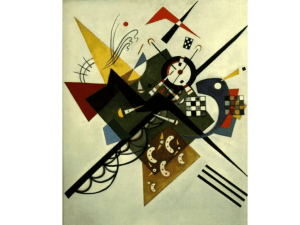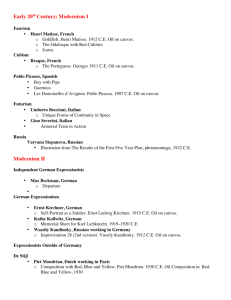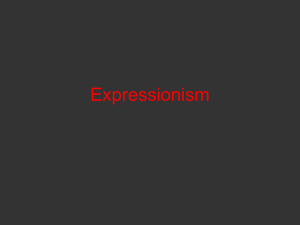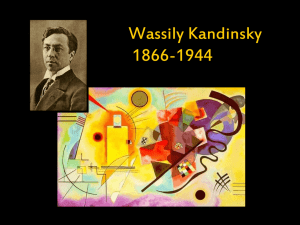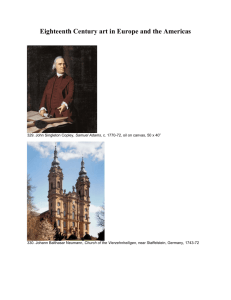Kandinsky
advertisement
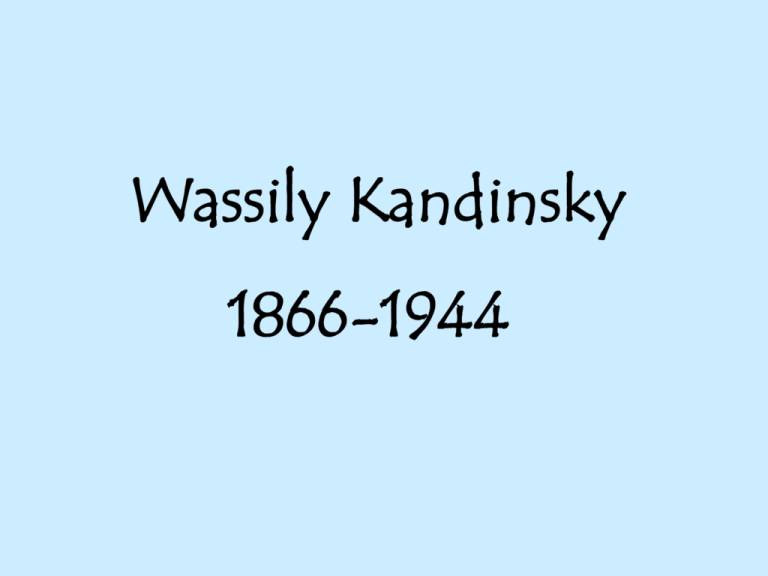
Wassily Kandinsky 1866-1944 Kandinsky, himself an accomplished musician, once said Color is the keyboard, the eyes are the harmonies, the soul is the piano with many strings. The artist is the hand that plays, touching one key or another, to cause vibrations in the soul. The concept that color and musical harmony are linked has a long history, intriguing scientists such as Sir Isaac Newton. Kandinsky used color in a highly theoretical way associating tone with timbre (the sound's character), hue with pitch, and saturation with the volume of sound. He even claimed that when he saw color he heard music Autumn in Bavaria 1908; Oil on cardboard, 33x45cm; Centre Georges Pompidou, Paris Improvisation 7 1910 (180 Kb); Oil on canvas, 131 x 97 cm; Tretyakov Gallery, Composition IV 1911 (170 Kb); Oil on canvas, 159.5 x 250.5 cm (62 7/8 x 98 5/8 in); Kunstsammlung Nordrhein-Westfallen, Dusseldorf Composition V 1911 (170 Kb); Oil on canvas, 190 x 275 cm (6' 3 7/8" x 9' 1/4"); Private collection Improvisation 31 (Sea Battle) Improvisation 31 has a less generalized title, Sea Battle, and by taking this hint we can indeed see how he has used the image of two tall ships shooting cannonballs at each other, and abstracted these specifics down into the glorious commotion of the picture. Though it does not show a sea battle, it makes us experience one, with its confusion, courage, excitement, and furious motion Black Spot I 1912 (200 Kb); Oil on canvas, 100 x 130 cm; The Hermitage, St. Petersburg Ravine Improvisation 1914 (110 Kb); Oil on cardboard, 110 x 110 cm; Stadtische, Munich Composition VI 1913 (170 Kb); Oil on canvas, 195 x 300 cm (6' 4 3/4" x 10'); Hermitage Museum, St. Petersburg Composition VII 1913 (200 Kb); Oil on canvas, 200 x 300 cm (6' 6 3/4" x 9' 11 1/8"); Tretyakov Gallery, Moscow Small Pleasures Fragment 2 for Composition VII 1913 (180 Kb); Oil on canvas, 87.5 x 99.5 cm (34 1/2 x 39 1/4 in); Albright-Knox Art Gallery, Buffalo, NY On White II 1923; Oil on canvas, 105 x 98cm; Centre Georges Pompidou, Paris Composition VIII 1923 (140 Kb); Oil on canvas, 140 x 201 cm (55 1/8 x 79 1/8 in); Solomon R. Guggenheim Museum, New York Black and Violet 1923 Contrasting Sounds 1924; Oil on cardboard, 70x49.5cm; Centre Georges Pompidou, Paris Yellow, Red, Blue 1925; Oil on canvas, 127x200cm; Centre Georges Pompidou, Paris Composition IX 1936 (120 Kb); Oil on canvas, 113.5 x 195 cm (44 5/8 x 76 3/4 in); Musee National d'Art Moderne, Centre Georges Pompidou, Paris Biography Born in Moscow in 1866, Kandinsky spent his early childhood in Odessa. His parents played the piano and the zither and Kandinsky himself learned the piano and cello at an early age. The influence of music in his paintings cannot be overstated, down to the names of his paintings Improvisations, Impressions, and Compositions. In 1886, he enrolled at the University of Moscow, chose to study law and economics, and after passing his examinations, lectured at the Moscow Faculty of Law. Soon thereafter, at the age of thirty, Kandinsky left Moscow and went to Munich to study lifedrawing, sketching and anatomy, regarded then as basic for an artistic education. Ironically, Kandinsky's work moved in a direction that was of much greater abstraction than that which was pioneered by the Impressionists. It was not long before his talent surpassed the constraints of art school and he began exploring his own ideas of painting - "I applied streaks and blobs of colors onto the canvas with a palette knife and I made them sing with all the intensity I could..." Now considered to be the founder of abstract art, his work was exhibited throughout Europe from 1903 onwards, and often caused controversy among the public, the art critics, and his contemporaries In 1933, Kandinsky left Germany and settled near Paris, in Neuilly. The paintings from these later years were again the subject of controversy. Though out of favor with many of the patriarchs of Paris's artistic community, younger artists admired Kandinsky. His studio was visited regularly by Miro, Arp, Magnelli and Sophie Tauber. Kandinsky continued painting almost until his death in June, 1944. his unrelenting quest for new forms which carried him to the very extremes of geometric abstraction have provided us with an unparalleled collection of abstract art. Composition X 1939 (160 Kb); Oil on canvas, 130 x 195 cm (51 1/8 x 76 3/4 in); Kunstsammlung Nordrhein-Westfalen, Dusseldo What do you think of Kandinsky’s work?
